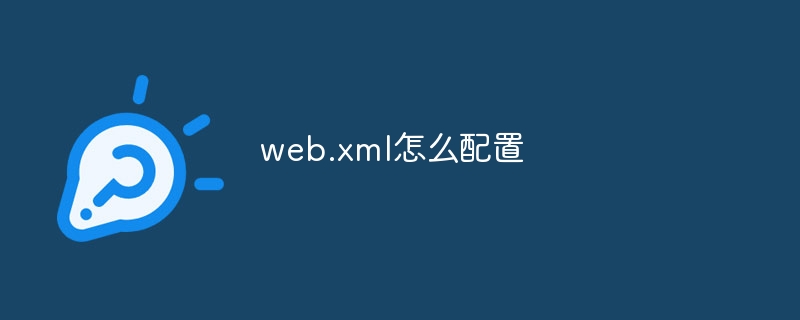The Web.xml file is a deployment descriptor for a Java EE web application that defines the application's configuration information, including Servlet, Filter, Listener, and ServletContext initialization parameters. It is located in the WEB-INF directory and mainly uses the following elements when configuring: web-app: represents the entire web application. servlet: Defines servlets, including Servlet name, class name, and Servlet mapping. filter: Defines Filters, including Filter names, class names, and Filter mappings. listener: Determine

Web.xml configuration
What is a Web.xml file?
The Web.xml file is a deployment descriptor file for Java EE Web applications. It defines the configuration information of the application, such as Servlet, Filter, Listener, and ServletContext initialization parameters.
How to configure Web.xml?
The Web.xml file is located in the WEB-INF directory of the application. It follows an XML structure and contains the following main elements:
- web-app: represents the entire web application.
- servlet: Defines servlets, including Servlet name, class name, and Servlet mapping.
- filter: Defines Filters, including Filter names, class names, and Filter mappings.
- listener: defines the Listener, including the Listener name and class name.
- context-param: Defines the ServletContext initialization parameter, which can be used in Servlets.
Configuration example
Configure Servlet:
<code class="xml"><servlet> <servlet-name>MyServlet</servlet-name> <servlet-class>com.example.MyServlet</servlet-class> <load-on-startup>1</load-on-startup> </servlet> <servlet-mapping> <servlet-name>MyServlet</servlet-name> <url-pattern>/my-servlet</url-pattern> </servlet-mapping></code>
Configure Filter:
<code class="xml"><filter> <filter-name>MyFilter</filter-name> <filter-class>com.example.MyFilter</filter-class> </filter> <filter-mapping> <filter-name>MyFilter</filter-name> <url-pattern>/*</url-pattern> </filter-mapping></code>
Configure Listener:
<code class="xml"><listener> <listener-class>com.example.MyListener</listener-class> </listener></code>
Configure ServletContext initialization parameters:
<code class="xml"><context-param> <param-name>my-param</param-name> <param-value>my-value</param-value> </context-param></code>
The above is the detailed content of How to configure web.xml. For more information, please follow other related articles on the PHP Chinese website!

Hot AI Tools

Undress AI Tool
Undress images for free

Undresser.AI Undress
AI-powered app for creating realistic nude photos

AI Clothes Remover
Online AI tool for removing clothes from photos.

Clothoff.io
AI clothes remover

Video Face Swap
Swap faces in any video effortlessly with our completely free AI face swap tool!

Hot Article

Hot Tools

Notepad++7.3.1
Easy-to-use and free code editor

SublimeText3 Chinese version
Chinese version, very easy to use

Zend Studio 13.0.1
Powerful PHP integrated development environment

Dreamweaver CS6
Visual web development tools

SublimeText3 Mac version
God-level code editing software (SublimeText3)

Hot Topics
 The Ultimate Guide to XML Namespaces: Simplifying Complex XML Structures
Jun 18, 2025 am 12:02 AM
The Ultimate Guide to XML Namespaces: Simplifying Complex XML Structures
Jun 18, 2025 am 12:02 AM
XMLnamespacesareimportantbecausetheypreventnamingconflictsinXMLdocuments.1)TheyallowtheuseofelementsandattributesfromdifferentXMLvocabularieswithoutclashes.2)Multiplenamespacescanbemanagedbyusingdifferentprefixes.3)Defaultnamespacescanbeappliedtoelem
 XML Namespace: Coding Guide
Jun 20, 2025 am 12:09 AM
XML Namespace: Coding Guide
Jun 20, 2025 am 12:09 AM
The coding guide for XML namespaces includes: 1. Declare the namespace using the xmlns attribute, such as. 2. Use prefix to refer to the namespace, such as. 3. The namespace URI is a unique identifier, not a real URL. 4. When using the default namespace, all unprefixed elements belong to the namespace, such as. 5. Use tools such as XSD to verify and debug namespaces. 6. Maintain prefix consistency and document readability and provide necessary comments.
 Well-Formed XML: The Foundation for Valid XML
Jun 19, 2025 am 12:05 AM
Well-Formed XML: The Foundation for Valid XML
Jun 19, 2025 am 12:05 AM
XMLisconsideredwell-formedifitadherestospecificsyntacticrules.Theserulesinclude:1)everyopeningtagmusthaveacorrespondingclosingtag,2)attributesmustbeproperlyquoted,and3)elementsmustbeproperlynested.Ensuringwell-formednessisessentialforcreatingaunivers
 XML: Are Namespaces required?
Jul 01, 2025 am 12:05 AM
XML: Are Namespaces required?
Jul 01, 2025 am 12:05 AM
XMLnamespacesarenotalwaysrequired,buttheyareessentialincertainsituations.1)TheyhelppreventnameconflictsinXMLdocumentscombiningelementsfrommultiplesources.2)Theycanbeomittedinsmall,self-containeddocuments.3)Bestpracticesincludeusingmeaningfulprefixesa
 XML rules: Common errors to avoid
Jun 22, 2025 am 12:09 AM
XML rules: Common errors to avoid
Jun 22, 2025 am 12:09 AM
Methods to avoid XML errors include: 1. Ensure that the elements are nested correctly, 2. Escape special characters. Correct nesting avoids parsing errors, while escape characters prevent document corruption, using an XML editor can help maintain structural integrity.
 XML Namespace: The most common Errors
Jun 27, 2025 am 01:00 AM
XML Namespace: The most common Errors
Jun 27, 2025 am 01:00 AM
XMLnamespacescancauseerrors,butthesecanberesolvedbyfollowingspecificsteps.1)Alwaysdeclarethenamespaceusingxmlnsattherootorwhereneeded.2)Ensureprefixesmatchthedeclarednamespaces.3)Useuniqueprefixesfordifferentnamespacestoavoidconflicts.4)Properlydecla
 XML well formed vs Valid: A full comparison
Jun 21, 2025 am 12:07 AM
XML well formed vs Valid: A full comparison
Jun 21, 2025 am 12:07 AM
XML is called "well-formed" to refer to its basic syntax correctness, while "valid" requires it not only well-formed, but also to conform to a specific pattern or DTD. 1. Well-formedXML needs to follow XML specifications, such as correct nesting of elements and correct use of tags. 2. ValidXML must comply with the structure and content rules defined by the schema or DTD.
 XML: Which are the best alternatives?
Jul 01, 2025 am 12:12 AM
XML: Which are the best alternatives?
Jul 01, 2025 am 12:12 AM
JSON,YAML,ProtocolBuffers,CSV,andTOMLaresuitablealternativestoXML.1)JSONisidealforreadabilityandeaseofuse.2)YAMLofferscleanersyntaxandsupportscomments.3)ProtocolBuffersexcelinhigh-performanceapplications.4)CSVisperfectforsimpledataexchange.5)TOMLbala






